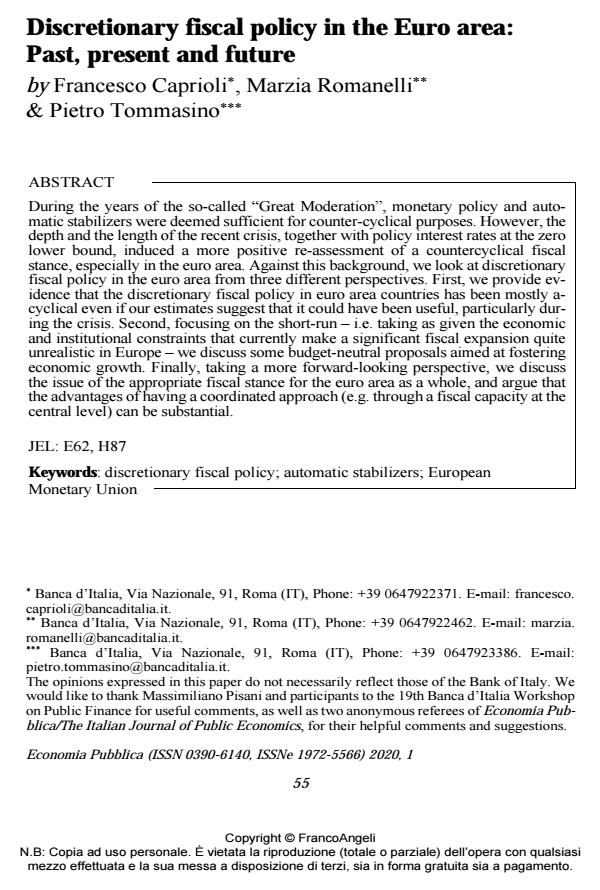Discretionary fiscal policy in the Euro area: Past, present and future
Titolo Rivista ECONOMIA PUBBLICA
Autori/Curatori Francesco Caprioli, Marzia Romanelli, Pietro Tommasino
Anno di pubblicazione 2020 Fascicolo 2020/1
Lingua Inglese Numero pagine 31 P. 55-85 Dimensione file 375 KB
DOI 10.3280/EP2020-001002
Il DOI è il codice a barre della proprietà intellettuale: per saperne di più
clicca qui
Qui sotto puoi vedere in anteprima la prima pagina di questo articolo.
Se questo articolo ti interessa, lo puoi acquistare (e scaricare in formato pdf) seguendo le facili indicazioni per acquistare il download credit. Acquista Download Credits per scaricare questo Articolo in formato PDF

FrancoAngeli è membro della Publishers International Linking Association, Inc (PILA)associazione indipendente e non profit per facilitare (attraverso i servizi tecnologici implementati da CrossRef.org) l’accesso degli studiosi ai contenuti digitali nelle pubblicazioni professionali e scientifiche
During the years of the so-called "Great Moderation", monetary policy and automatic stabilizers were deemed sufficient for counter-cyclical purposes. However, the depth and the length of the recent crisis, together with policy interest rates at the zero lower bound, induced a more positive re-assessment of a countercyclical fiscal stance, especially in the euro area. Against this background, we look at discretionary fiscal policy in the euro area from three different perspectives. First, we provide evidence that the discretionary fiscal policy in euro area countries has been mostly acyclical even if our estimates suggest that it could have been useful, particularly during the crisis. Second, focusing on the short-run - i.e. taking as given the economic and institutional constraints that currently make a significant fiscal expansion quite unrealistic in Europe - we discuss some budget-neutral proposals aimed at fostering economic growth. Finally, taking a more forward-looking perspective, we discuss the issue of the appropriate fiscal stance for the euro area as a whole, and argue that the advantages of having a coordinated approach (e.g. through a fiscal capacity at the central level) can be substantial.
Parole chiave:Discretionary fiscal policy; automatic stabilizers; European Monetary Union
Jel codes:E62, H87
- The future of European fiscal governance: a comprehensive approach Marzia Romanelli, Pietro Tommasino, Emilio Vadalà, in SSRN Electronic Journal /2022
DOI: 10.2139/ssrn.4109512
Francesco Caprioli, Marzia Romanelli, Pietro Tommasino, Discretionary fiscal policy in the Euro area: Past, present and future in "ECONOMIA PUBBLICA " 1/2020, pp 55-85, DOI: 10.3280/EP2020-001002